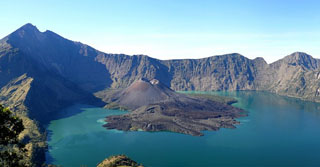Report on Rinjani (Indonesia) — 11 November-17 November 2015
Smithsonian Institution / US Geological Survey
Weekly Volcanic Activity Report, 11 November-17 November 2015
Managing Editor: Sally Sennert.
Please cite this report as:
Global Volcanism Program, 2015. Report on Rinjani (Indonesia) (Sennert, S, ed.). Weekly Volcanic Activity Report, 11 November-17 November 2015. Smithsonian Institution and US Geological Survey.
Rinjani
Indonesia
8.42°S, 116.47°E; summit elev. 3726 m
All times are local (unless otherwise noted)
Based on observations conducted at a volcano observation post in the village of Lawang Sembalun, PVMBG reported that during 11-13 November dense white-and-gray plumes rose as high as 2.6 km above Rinjani’s Barujari crater. Elevated levels of continuous tremor were detected by the seismic network, although RSAM values showed a declining trend. Strombolian activity continued to feed N-to-E-trending lava flows. A lava flow entered lake Segara Anak, causing an increase in the lake level and increased flow in the Kokok Putih river. The Alert Level remained at 2 (on a scale of 1-4); visitors and residents were warned not to approach the crater within a 3-km radius. BNPB reported on 14 November that ash plumes rose as high as 1.6 km and drifted WSW; ashfall was reported in some villages downwind. The report also noted that flight conditions were normal at the airport. Based on satellite observations, the Darwin VAAC reported that during 15-17 November ash plumes rose to altitudes of 3.7-4.3 km (12,000-14,000 ft) a.s.l. and drifted as far as 240 km NW, WNW, W, and SW.
Geological Summary. Rinjani volcano on the island of Lombok rises to 3726 m, second in height among Indonesian volcanoes only to Sumatra's Kerinci volcano. Rinjani has a steep-sided conical profile when viewed from the east, but the west side of the compound volcano is truncated by the 6 x 8.5 km, oval-shaped Segara Anak (Samalas) caldera. The caldera formed during one of the largest Holocene eruptions globally in 1257 CE, which truncated Samalas stratovolcano. The western half of the caldera contains a 230-m-deep lake whose crescentic form results from growth of the post-caldera cone Barujari at the east end of the caldera. Historical eruptions dating back to 1847 have been restricted to Barujari cone and consist of moderate explosive activity and occasional lava flows that have entered Segara Anak lake.
Sources: Pusat Vulkanologi dan Mitigasi Bencana Geologi (PVMBG, also known as CVGHM), Badan Nacional Penanggulangan Bencana (BNPB), Darwin Volcanic Ash Advisory Centre (VAAC)

